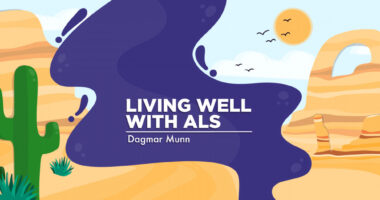How my ‘ex-straw-ordinary’ straws help me in living with ALS
The simple utensil that's part of my arsenal in fighting my dysphagia

I collect drinking straws. Not just any old straws, mind you, but long, wide-barreled plastic straws. My assortment includes several unusual straws as well, and they all help me drink beverages with ease even though I have dysphagia, or difficulty swallowing — a symptom of ALS.
As I wrote in “When ALS Becomes a Hard Act to Swallow,” I started having swallowing issues during my fourth year of ALS. The first major incident, while drinking a glass of water, became several minutes of gagging, coughing, and gasping for air. Afterward, my ALS clinic confirmed that I indeed had dysphagia. Although I could still chew and swallow solid food, thin liquids were my challenge. I began adding a powdered thickener to all my liquids — and using a straw.
Using a straw keeps my chin down, which helps to close off my airway. That, combined with the thickening powder, helps guide the liquid past my slow-reacting throat muscles so it all ends up in my stomach, as it should, and not in my lungs.
I use a repurposed plastic straw from a fast-food restaurant at home. When dining out, I use the restaurant-provided straw.
Surviving the ‘straw wars’
Then, just four years later, a new curveball came my way. I learned of a growing worldwide environmental movement to ban plastic straws completely. What?
In 2018, California banned plastic straws in certain restaurants unless customers asked for one. Soon several major cities and the European Union followed with their own bans. I noticed that here in Arizona, which has no ban, our local restaurants were joining the trend by offering paper straws or no straws at all.
Fearing I’d be accused of smuggling contraband into local restaurants, I pondered if I should use a marking pen to print “Medical Assistive Device” in tiny letters down the side of each of my straws. OK, OK, it was only a brief consideration.
The pandemic came next, and I silently rejoiced as plastic straws became acceptable here again. During this period, however, I decided to diversify my selection. Thanks to a few thoughtful birthday gifts from my daughter, I own several collapsible, stainless-steel straws with their own carrying cases and long, skinny brushes for cleaning. I can fit one easily in my purse so I’m confident I’ll always have a straw handy, no matter what.
In addition, a short straw sits near my laptop and has become a permanent addition to my daily exercise routine to help me improve my ability to speak. Just by spending a few minutes every day breathing, humming, and singing through a straw, I can relax the muscles surrounding my vocal cords and in my neck, reducing the fatigue I feel when speaking.
I’ve also found it convenient to carry my thickened drink in a small sports bottle with a built-in straw. It’s handy for car trips and meetings because I blend right in with others who’ve brought along their own bottles of water.
Living with dysphagia, one of many tests that ALS throws our way, certainly has its challenges. But if we use a little humor, keep a positive attitude, and rely on our adaptability, I believe we can live well while living with ALS.
Note: ALS News Today is strictly a news and information website about the disease. It does not provide medical advice, diagnosis, or treatment. This content is not intended to be a substitute for professional medical advice, diagnosis, or treatment. Always seek the advice of your physician or other qualified health provider with any questions you may have regarding a medical condition. Never disregard professional medical advice or delay in seeking it because of something you have read on this website. The opinions expressed in this column are not those of ALS News Today or its parent company, Bionews, and are intended to spark discussion about issues pertaining to ALS.







Jerry Tobias
I drink a lot of the coconut Bai and because of my ALS I was always spilling it. I had my grandson drill a hole in several old lids or caps from them. Now I carry my drink and caps with me. I have bulbar onset and this helps me with my drinking. Thanks for writing this, I hope it helps others.
Lisa Baugh
Dagmar Munn,
Would you be able to video yourself doing the straw exercises you talked about? My husband can not swallow food and is on a feeding tube and receives all nutrition through formula. My husband Todd can sip liquid but he does choke sometimes. But what I was really interested is how you said it helped you by relaxing vocal cords and not take all of your energy to talk. Todd struggles when several people may call or family get togethers he gets really tired. If the exercises work for you maybe it could help him. Thank you
Dagmar Munn
Hello Lisa,
Rather than making you wait for me to film a video, here is a link to the video that demonstrates exactly what I do: https://youtu.be/0xYDvwvmBIM?si=pH3Lr1ALvnRIEYuF
Also, the column where I wrote about using a straw to help my voice: https://alsnewstoday.com/columns/dysarthria-exercises-include-singing-through-straw/
I hope these will help your husband. When speaking remind him to sit tall, breathe with his diaphragm not upper chest, and speak using the diaphragm muscle. https://alsandwellness.blogspot.com/2024/10/im-still-talking-and-sharing-strategies.html
Dagmar
Crystal Sanford-Brown
Dagmar,
Thank you for sharing the awesome suggestion of using a straw throughout the day to assist with breathing while speaking. No white flags! We're not giving up 😀
Take care
Mary
Hello! I love reading your column. I was diagnosed Jan 24. Your column gives me hope. I appreciate your positivity. We need the most positive attitude we can have to live our best life! I just started reading your free book. I’m loving it! I want to be like you when I grow up! I’m 52! Thanks!
Dagmar Munn
Thank you Mary for your kind words... and kudos! If you've found my ALS and Wellness Blog, I hope some of my posts will be of further help and inspiration for you. Dagmar
https://alsandwellness.blogspot.com/2017/09/als-and-wellness-blog-archives.html